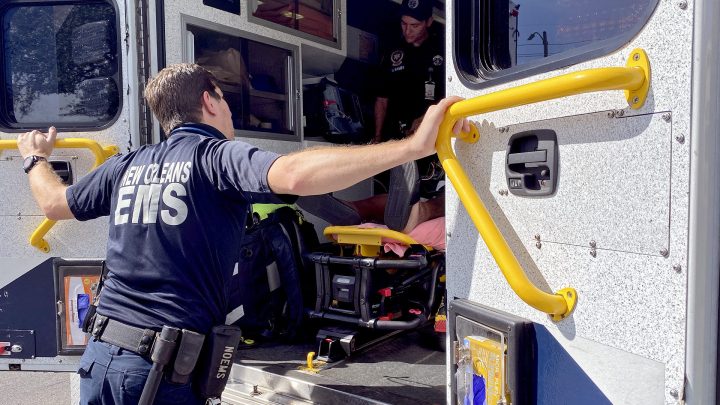
Strapped emergency services struggle to answer 911 calls

Hospitals and clinics across the nation are buckling under the weight of a staffing shortage, exacerbated by the COVID-19 pandemic. Emergency services and ambulatory care providers are also struggling to answer an increasing amount of 911 calls.
That was apparent when New Orleans Emergency Medical Services Lt. Noah Feldman received a 911 call to help a woman in labor in mid-November. The woman, who went to her local community health center for a primary care visit, ended up feeling tremendous pain in her abdomen. The 911 dispatcher told Feldman that the woman needed an emergency cesarean section.
“We’re going to a labor and delivery in progress,” Feldman said, as he turned on his siren and bounded down the bumpy streets of the city. “They said the baby is possibly breached.”
But Feldman wasn’t driving an ambulance — he was driving “a sprint unit,” which is basically an SUV with a siren and without back seats. It doesn’t transport patients, but it’s packed with medical supplies so Feldman can give emergency care until an ambulance shows up.
New Orleans EMS didn’t have an ambulance available at the time of the pregnant woman’s call. So Feldman was called to the health center to attend to the woman, who was stretched out on a clinic bed and attached to an ultrasound. He was able to administer emergency care if an ambulance didn’t come soon.
“We didn’t have a unit available because they were stuck on the wall,” Feldman said as he shuffled medical supplies into an official supply carrier bag.
Being “stuck on the wall” is a phrase used in health care to describe what happens when an ambulance reaches a hospital and EMS personnel have to wait in the triage portion of the facility because a doctor or room is not yet available for the patient. The ambulance can’t leave unless EMS workers put the patient into the hospital’s care and custody — a process that requires checking in the patient and doing some paperwork. So the ambulance is essentially stuck outside the hospital walls during the wait.
Data acquired from EMS agencies in Louisiana that showed the number of patients who ended up stuck on the wall of a hospital before receiving a bed has gone up by 122% in New Orleans since 2019 — more than double what it was before the COVID-19 pandemic. That means more and more ambulances are tied up.
This isn't just happening in New Orleans.
“The root cause of it is a staffing crisis," said Justin Back, president of Acadian Ambulance Service based in Lafayette, Louisiana, a few hours away. "It’s a lack of capacity on the provider side, on the transport entity side as well.”
Back said across the country, health care workers are retiring or quitting because of burnout and low pay. It’s hard to recruit people into health care too. That means hospitals often don’t have enough staff to accept patients in ambulances quickly.
Emergency medical companies are struggling as well. New Orleans has a 40% turnover rate among its staff.
“In a lot of cases, EMS are the safety net provider in a lot of rural communities. And so this is a very, very dangerous place for the industry in the nation to be,” Back said.
In Louisiana and other Southern states, Acadian Ambulance has started offering to pay for school, training and certification for people interested in becoming emergency medical technicians.
“We have been able to identify and remove certain barriers to entry, which include financial barriers and technological barriers to entry for people starting EMT school with us,” Back said.
But so far, no one thing is getting patients through the system faster. It’s not enough.

Fortunately, New Orleans EMS, along with others in the state, have formed partnerships to adapt to wall time increases. In Feldman’s case, a unit from Acadian Ambulance in another parish was able to assist him that day and transport the patient to her emergency C-section.
After helping with the woman with the breached baby and answering a few other 911 calls, Feldman turned back to a trauma center in the heart of New Orleans.
There, about half a dozen ambulances from all across the state — some that traveled from hours away — were lined up. All of them were waiting to transfer patients to the hospital so that they could go back into service.
Feldman said progress will depend on recruiting people and setting them up to thrive so they decide to stay and take those 911 calls. After he was interviewed for this story, Feldman decided to leave his post with the agency to become a physician assistant but will stay in New Orleans EMS’ reserves.
There’s a lot happening in the world. Through it all, Marketplace is here for you.
You rely on Marketplace to break down the world’s events and tell you how it affects you in a fact-based, approachable way. We rely on your financial support to keep making that possible.
Your donation today powers the independent journalism that you rely on. For just $5/month, you can help sustain Marketplace so we can keep reporting on the things that matter to you.











